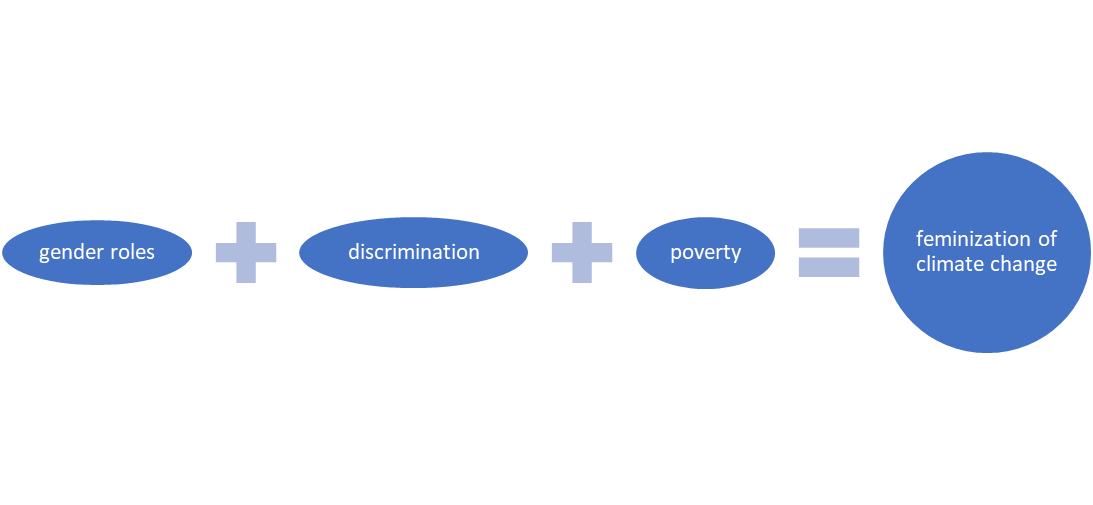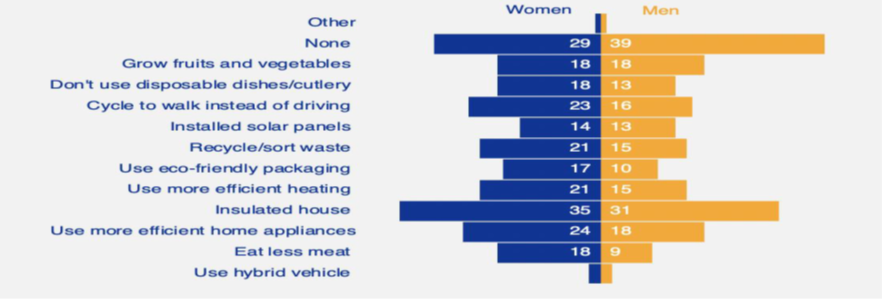Numbers and narratives are equally gender unequal -when it comes to climate change-
Part 3: Who emits more greenhouse gases: men or women?- {{"article.by"|translate}} Olgica Apostolova with contribution from Filip Kondovski
- {{"article.posted"|translate}} 28-07-2021
Numbers and narratives are equally gender unequal -when it comes to climate change-
Part 3: Who emits more greenhouse gases: men or women?
GHG emissions are not gender neutral. GHG emissions are male dominated. In other words, the GHG emitters are defined by gender, and are strongly depending on the everyday (gender-based) activity at individual level, based on the gender-roles in the family and society.
In the first Blog Part 1: Women as agents of change we clearly highlighted that women are less represented in the decision-making processes for designing the climate change national policies and measures as well as at the home level decisions making, and at the same time it is obvious that their potential, as real agents of change, is not fully recognized in the efforts to combat climate change.
The second one, Part 2: " Mitigating climate change: who benefits more?" deals with the (non) existing gender structure and dimension of the mitigation measures, that has to be seriously addressed by clearly defining different climate related vulnerable groups in different climate-related sectors, and ultimately cross-referenced by gender.
If women are less represented as agents of change, are less represented as users of mitigation measures (in policies` development and as beneficiaries), now we have to go back to the roots of the problem: Who produces more greenhouse gases: men or women?

According to the latest National GHG Inventory report “the greatest share of emissions is from the Energy sector, accounting for 73.7% in 2016, followed by the Agriculture (excluding FOLU) with 11.8% and IPPU sector with 8.5% and Waste sector with 6% share. The dominant share of emissions for the Energy sector is evident throughout the whole time series (1990-2016)”. According to the same report “most of the GHG emissions in 2016 occur in the category Energy Industries (51.0%), followed by Transport (28.1%) and Manufacturing Industries and Construction (13.9%). The other two categories together account for 5% of the total emissions in 2016 and the remaining around 2% are Fugitive emissions”.
There are no official sex-disaggregated statistics on the GHG emitters at individual (personal) level, but still, the available sex-disaggregated data are showing differences in certain aspects of the GHG emissions where we can see the gender-based differences in activities, patterns and behaviors – strictly depending on the poverty criteria as well as on gender-based roles in the family and society.
Poverty as a factor for GHG emissions. The most vulnerable groups in terms of energy (and classic) poverty, and therefore are using wood as household heating are as following: Single mothers living in houses with children under the age of 18, using firewood, Single fathers living in houses with children under the age of 18, using firewood, Women 65+ age, with monthly income beyond 12.000 MKD single, divorced or widower and live alone, Men 65+ age, with monthly income beyond 12.000 MKD, single, divorced or widower and live alone (Data are taken from the Socio-economic analysis of the household heating patterns – also presented in the Macedonian Gender and Climate Change Indicators).
On the other hand, female`s share of the unemployment and poverty rate is higher than male which as it was argued in previous Blogs, correlates to the (financial) abilities to practice, buy, purchase climate friendly practices, services, devices, patterns, behaviors etc., as regards to the poverty connections.

Is female share in this case, bigger in the GHG emitters proportion? No!
As opposite to the poverty dependance as a basis for emitting GHG, according to some gender and climate change studies, women are showing bigger concern on the climate change issue and are more willing to accept new behavioral practices that are contributing to the decrease of the GHG emissions, but, they are less engaged into the decision-making positions, less likely to manage and control family budgets due to the cultural patterns, as well as due to their dependence on the male family income.
let’s look at the gender based actions (undertaken by men and women) to reduce the GHG emissions (taken from the Narrative Study – Gender and Climate Change, Macedonia - micronarratives which provided perspective on the daily challenges of the Macedonian citizens regarding climate change.

Men are more represented only into the “No action undertaken” category.
Second, and very crucial issue is the control of the industries as well as national institutions related to energy, and other GHG related sectors, are showing male dominance. Men are still leading the main decision-making positions, and consequently, processes leading towards increase or decrease of the GHG emissions, and at the production level, are dominating the labor force in the GHG related sectors. Men are dominating the industries and decision-making processes in the private and public sectors related to the GHG. The sex-disaggregated data in the Governmental` institutions decision making structure, after the Parliamentarian Elections 2020, shows extremely low female participation in the Ministerial, Deputy Ministerial and State Secretary positions in the Ministries related to GHG and Mitigation sectors (Transport, Agriculture, Economy, Environment, Finance, Health, Labor and Social Policy).
Female`s share in the decision-making positions in energy companies are showing lower or non-participation of women (ELEM33% women in Management board, and 14% in Supervisory Board. EVN Macedonia 0% women in Management board and 11% in Supervisory board).
Once again, this indicates that we cannot see women as “agents of change” here, or more precisely, women are disabled of being “agents of change”.
In parallel, Transport numbers are clearly confirming the fact that men are main GHG emitters. Recent data obtained from Ministry of Interior demonstrates that 71% of car owners are men and 13% are women thus forming at least two assumptions: One is that women tend to use more environmentally friendly means of transport or use more often the public transport services and secondly this number is due to the lack access of financial capital necessary to buy a vehicle which correlates with the greater unemployment rates for women. Nonetheless, this can be related with the inheritance practices that the family vehicle is usually inherited by the son rather than the daughter, which is case with land ownership[1].
GHG emissions are not gender neutral. GHG emissions are male dominated. In other words, the GHG emitters are defined by gender, and are strongly depending on the everyday (gender-based) activity at individual level, based on the gender-roles in the family and society.
It is crucial to incorporate gender dimension in the GHG emitters (at individual and societal level), in order to develop effective mitigation (and adaptation) measures, first of all, in order to investigate which are the most important gender based in practices and impacts that can contribute towards decrease of the GHG emissions, on one hand, and on the other, to make sure that mitigation and adaptation efforts are not contributing to the existing gender inequalities.
-
Корисни линкови
26-01-2021 -
Справување со климатските промени и загадувањето на воздухот во градот Скопје
29-04-2018 -
Финансирање во климата
28-01-2022 -
Микронаративи
08-06-2022
{{"article.lastestPosts"|translate}}
-
Нови финансирања за унапредување на природата и биолошката разновидност на Зелената агенда за Западен Балкан
11-03-2025 -
Започна проектот за развој на 1-от и 2-от двогодишен извештај за транспарентност и 5-от национален извештај за климатски промени на С.Македонија
04-03-2025 -
Земјоделски форум за климатски промени: Се изнаоѓаат решенија за поголема климатска отпроност на заемјоделието
02-12-2024 -
Заврши COP29, центарален фокус на финасирањето за климата
02-12-2024




 Мод за знаковен јазик
Мод за знаковен јазик Говорен асистент
Говорен асистент Означи линкови
Означи линкови

 Зголеми маус
Зголеми маус